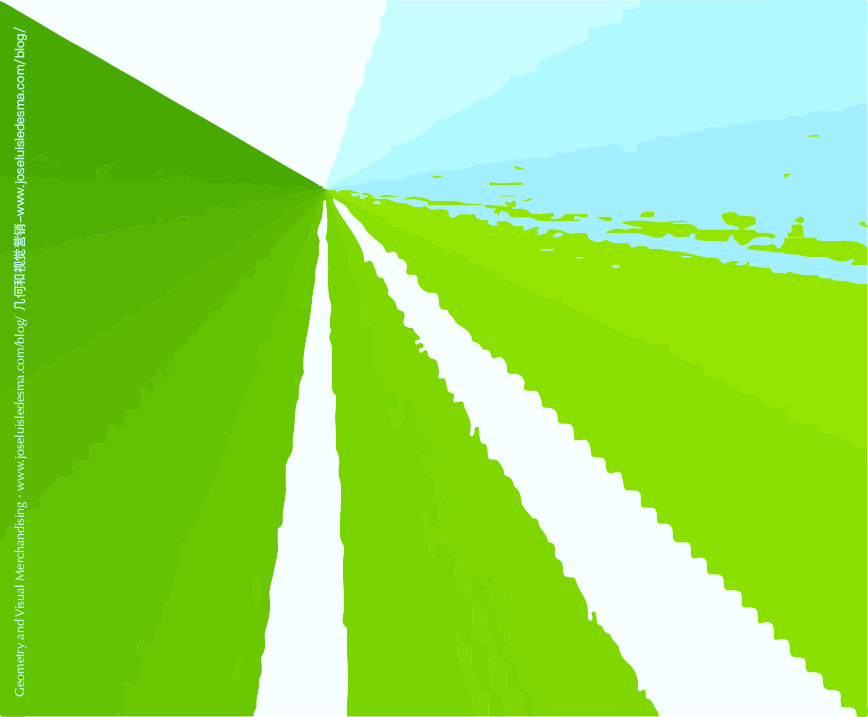Geometry and Visual Merchandising

Geometry is everywhere, wherever you look you can discover shapes such as triangles, circles, rhombuses, squares or hexagons.
From art to architecture, cinema to fashion, there are many areas that use geometric shapes as the basis for their creations.
Particularly in interior design and retail decoration, symmetry and geometry play a key role in creating proportionate and harmonious spaces.
“Seeing the world through geometry is not only essential for composing, but it’s also downright fun”. – Jose Luis.
Geometric elements are a great eye-catcher. That is why it is important to find the right balance with the rest of the decorations.
The connection that exists between the design and distribution of the different elements that compose a space to make it harmonious is indisputable. Geometry means order, and because of this, things as simple as straight lines can be transformed into figures that we can perceive as visual harmonies.
Geometry and decoration
Geometric patterns allow us to play with different visual effects, so that we can give any space a more modern and innovative look.
Geometric design can be adapted to the decoration of practically any place, and by making the right use of this resource we can modify the proportions and dimensions of a given space.
Knowing the meaning of these geometric shapes is fundamental when designing our space.
The meaning of the shapes
When we refer to the design of spaces, the geometric shapes that have the most presence are the circle, the square, the triangle and the rectangle.
Thanks to these shapes, it is possible to create infinite possibilities to achieve a sense of harmony at the point of sale.
Symmetry, modularity and repetition can also be implemented to stimulate a variety of sensations and feelings for consumers. In fact, geometric shapes are a fantastic tool for visual merchandising since consumers are familiar with their shapes.
Understanding the meaning of each shape will give us a key perspective when designing our Visual Merchandising strategy and our retail space.
Square
The square is the basis of all geometry, this shape is associated with stability, firmness and trajectory.
This modulation allows a design to be configured in an orderly manner. If you also add colour or textures to the design, you get an endless number of solutions, all equally effective.
When drawing, you feel the straight lines and right angles of the square, and you feel a strong tension. This tension is often used for minimalist design structures.
All geometric shapes or figures that are based on horizontal and vertical lines belong, by their character, to the family of the square.
Triangle
The fundamental character of the triangle comes from the three diagonals that intersect at the angles. Its acute angles offer an aggressive and combative aspect.
The triangle generates direction, dynamism, is unstable and transmits energy.
The triangle family includes all diagonal shapes such as the rhombus, the trapezoid, the zigzag and the shapes derived from it.
The triangle symbolizes the thinking and is recommended for children’s exhibitions that aim to break structures or represent movement.
A figure as simple as a triangle manages to order the space. By combining inverted triangles, we can make rhombuses, which placed randomly on a wall create a visual mural.
Circle
The circle is considered the mother of all shapes and is therefore associated with the idea of movement, perfection and freedom. Its constantly curved perimeter creates a sensation of displacement, making it a good choice for conveying a message of velocity.
A circle is born when a point moves while maintaining a constant distance from another point. In contrast to the rough and tense impression produced by the outline of a square, the circle produces a feeling of relaxation and perpetual movement.
It symbolizes the spirit that moves in its unity and means: warmth, protection and creativity.
To the circle family belong all curved geometric shapes, such as the ellipse, the ovoid, the parabola and its derivative shapes.
There is no direction in this shape, and the feeling of looking at a circle is that of moving continuously, as if it were an infinite reading path.
Rectangle
The rectangle offers different stable options than a square, thanked to its equal sides two by two. It is the most common geometric shape in design. It’s represents honesty, solidity and stability. The combination of rectangles of different sizes is interesting and attractive.
Hexagons
This apparently simple shape can be found in everyday life. In the field of design and retail, this geometric figure makes it possible to create structures that lie between a polygon and a circle thanks to its degree of roundness. It is a powerful and fascinating way to convey balance and conviction.
The basic geometric figures and colours are the primitive forms of expression, and the main elements for transmitting sensations and emotion in the composition of an exhibition.
Do not hesitate to count on a Visual Merchandising professional to help you with your strategy and the design of your retail space.
Sources: teresagalan.es; semrush.com; designshack.net; blog.ida.cl; uxdesign.cc; joseluislededesma.com.



